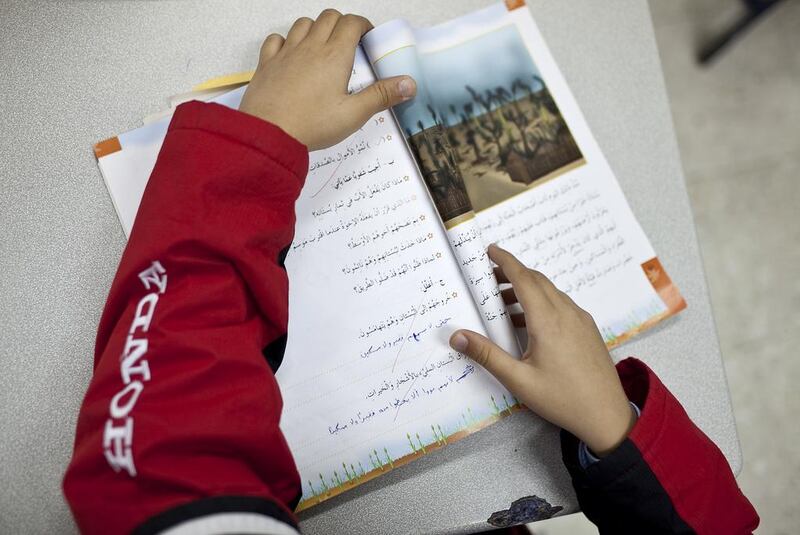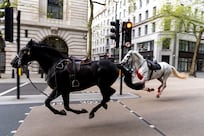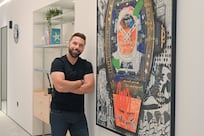As you read this sentence, are you aware of which part of each word your eyes are directing their gaze at?
Almost certainly not, because when we sit down with a newspaper or a book, or read a text message or email, we recognise words without realising how we are doing it.
Although our actions are unconscious, researchers can determine where in a word our eyes look first, how long we look at words and how these things are affected by, for example, word length.
Until now, most work has been done with languages such as English, French and German, that use Latin or Roman script. Arabic has attracted much less academic attention.
“Hardly anyone is doing it. It’s important – it’s the second most widely read alphabetic language in the world,” says Dr Kevin Paterson, a senior lecturer in psychology at the University of Leicester, UK.
Dr Paterson and a team of co-researchers, including Prof Timothy Jordan, a psychologist at Zayed University in Dubai, have just released findings that help to pinpoint how people see words in Arabic and how reading methods compare with those of English. They analysed how readers fixate, or direct their eyes at, words, studying where along in a word fixation takes place and how long it lasts.
The work is not just of interest to academics, as knowledge of the processes of how the eyes see words in Arabic could help lead to a greater understanding of conditions such as dyslexia, in which people find it difficult to recognise and to spell words.
Word fixation can be an important factor in dyslexia, with most dyslexic children showing abnormal eye-fixation behaviour, says Prof Rod Nicolson, an executive editor of the journal Dyslexia.
“To fixate the word on the page, you need to have both eyes focused on it and to keep that focus there,” says Prof Nicolson, who is based at the department of psychology in the University of Sheffield, UK.
“There’s a long-standing theory that suggests dyslexic children do have specific difficulties with eye fixation, especially binocular fixation – both eyes.
“There’s also evidence that dyslexic children, even if they’re able to fixate words, they might have difficulties in jumping to the next word.”
Like languages such as English, Arabic is alphabetic, but it differs in that it runs from right to left and is written in a cursive script, meaning the letters are joined together. Also, Arabic tends to have a more complicated relationship between spelling and pronunciation, and it has diacritics, which are signs or marks that help to indicate pronunciation. Such complicating factors could affect the way the eye behaves when it recognises words.
Earlier work on Arabic by scientists at King Saud University in Riyadh, Saudi Arabia, unveiled at a conference in Austria in 2010, found that dyslexic readers fixated words for longer periods, had shorter eye movements between fixation points and, when reading, had more backward movements of the eye, known as regressions.
The new research, published in Psychonomic Bulletin and Review, involved 12 native Arabic speakers who were asked to look at text that included three, five and seven-letter words in their mother tongue.
Simultaneous to this, an eye tracker recorded the position of the gaze of each person’s right eye every millisecond. Among the team of researchers was a native Arabic speaker, Abubaker Al Mabruk, from Libya.
The researchers found that, with short words, fixation took place in the middle of the word, while with longer words, the eyes fixated earlier on in the word. As with English and other languages using the Latin alphabet, longer words were fixated for longer and were more likely than shorter words to be fixated in the first place.
One conclusion from the work is that, despite the differences between Arabic and English, effects of word length can be important across a wide range of languages. Also, even with very different alphabetic systems, how many letters a word has plays an important role in guiding eye movements.
“It was quite gratifying there were similar effects across alphabetic languages,” says Dr Paterson, who has worked alongside Prof Jordan in the past to study similar processes in the reading of English. “The length cue is important because it provides the reader with useful information about where to look next.
“Shifting to the next word, moving your eyes, being able to shift your point of gaze – beginner readers, it’s something they have to learn to do.”
People with visual problems or with word-recognition issues linked to dyslexia may have difficulties with these component processes, so uncovering them could prove helpful to researchers looking at dyslexia in Arabic.
“We don’t know the difficulties associated with dyslexia; there are some ideas but it’s still not fully understood. You have to know what’s typical,” says Dr Paterson.
“You have to know what’s typical because, once you can understand how skilled readers can read you have a good understanding of what might go wrong. That’s our starting point as far as Arabic is concerned.It’s an important basis to do further research into how Arabic is read.”
Vince Connelly, a professor of psychology at Oxford Brookes University, UK, said fundamental studies that focus on Arabic, like this one, can be useful even to researchers looking at dyslexia in English.
“What’s particularly useful is the cross-language element. Quite a lot of our understanding of reading, spelling and writing has gone on in English for a number of historical and cultural reasons,” he says.
Because so much work has been focused on English, he says it is difficult to determine the extent to which particular characteristics of the language contribute to the difficulties some people have with reading.
“When you get cross-cultural studies like this you can pull together a more coherent theory of how the brain begins to process and deal with language in general terms,” he says.
“There will be specific aspects of some languages that make things different, but the more we understand about the general principles the better.”
newsdesk@thenational.ae
Daniel Bardsley is a UK-based freelance journalist and former reporter at The National. He has science degrees from the University of Oxford and the University of East Anglia.







